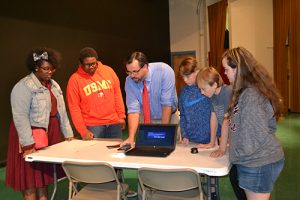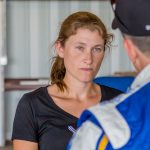
SNOW HILL – Students in Worcester County are encouraged to shoot for the stars.
Some of them are taking that advice literally.
In a new after school program, two dozen Snow Hill Middle School students are designing satellites that will be launched with an Antares rocket from NASA’s Wallops Flight Facility in 2018.
“This is cutting edge,” science teacher Everett Evansky said.
Snow Hill Middle School (SHMS) is the only middle school in the state that has partnered with the Virginia Commercial Space Flight Authority on the new ThinSat project, a program designed to promote interest in STEM (Science, Technology, Engineering and Math) fields. Through it, students build small satellites to measure atmospheric conditions.
“The program is helping kids to learn about the chemical and physical properties of our atmosphere,” Evansky said.
He discovered the ThinSat project, which is funded by the Virginia Commercial Space Flight Authority, after Principal Chris Welch encouraged him to see if it would be suitable for SHMS.
“I went to Wallops and I immediately saw this was a powerful program with so much potential,” Evansky said.
Close to 50 students applied to take part in the program at SHMS, which is limited to 24, so Evansky selected students based on their grade point average and level of interest. He’s currently guiding those who were chosen through the first phase of the project, the construction and testing of x-chips. The chips contain sensors connected to a wireless transmitter. When they’re launched into the air with helium balloons, students will be able to get livestream data from the troposphere.
“It’s a great way for kids to have a hands-on connection,” Evansky said.
The second phase of the ThinSat program will involve students designing a prototype model to monitor ozone that will be sent skyward with a high-altitude weather balloon.
“We’re going to be monitoring and measuring and transmitting data looking at what’s happening in the atmosphere as it’s moving through those levels and right through the ozone layer,” Evansky said.
Toward the end of the school year, the project will culminate with SHMS students submitting a research proposal to Morehead State University.
“Morehead will be building an actual ThinSat,” Evansky explained.
That ThinSat will be sent to Wallops Flight Facility, where, with the rest of the student-designed ThinSats, it will be attached to an Antares rocket bound for the International Space Station. Evansky said the ThinSats would be ejected 120 miles up, where they will orbit the earth, transmitting data, for up to 10 days.
“How cool is that?” Evansky said.
Though they had little understanding of the project when they applied to take part, Evansky’s students said all it took was the word science to get their interest.
“It’s just fun,” student Sage Labesky said.
Eighth-grader Elizabeth Thornton agreed. She’s hoping to be a veterinarian someday and knows that an understanding of science will make that possible. She says it plays a part in every aspect of life.
“You’ve got to know science,” she said.

